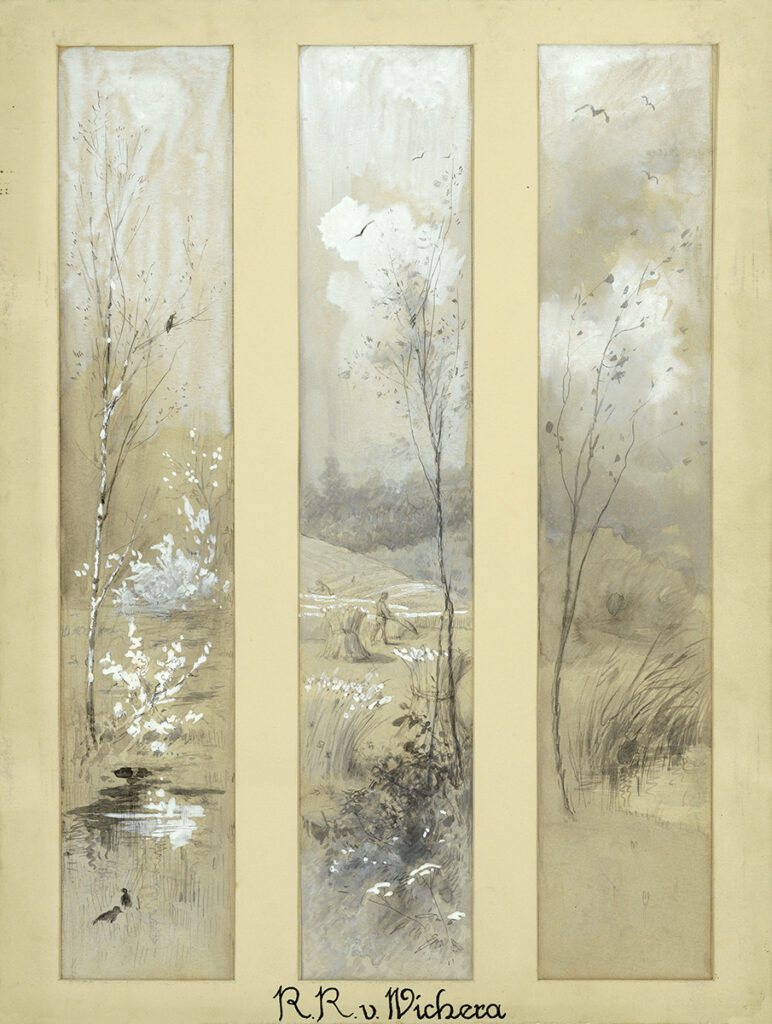Spring – Summer – Autumn is a small poetic drawing consisting of three plans. Each of them represents a certain season, from right to left it is spring, summer, autumn. It captures nature in its typical state for the given season. The artist portrays spring in the form of awaking nature along with birdlife, summer is represented by field works – scything and harvesting and autumn depicts bare trees and their typical melancholic mood. In spite of their very intimate format, the individual drawings are very detailed, including his realistic depictions of trees, animals and people, which only underscores the subtleness and fineness of the work. It represents a less typical part of the artist’s portfolio.
Wichera was better known for his figural and portrait paintings. While the artist’s early images are distinctively influenced by his Vienna mentor professor Hans Makart and carry a certain level of portrait realism, his later images from the 1890s, when the artist had already been working in Vienna, mostly lean toward idealised and stylised portrayals of young girls and women with flower bouquets – in today’s language, we could call them mainstream portraits. He also worked on historical paintings and still lifes.
Most of Raimund Wichera’s works have been donated to the Nitra Gallery collection by the artist’s niece Malvína Wicherová (born 1886) who inherited the images from Wichera’s siblings – her mother Vilemína (born 1858) and uncle Ferdinand (born 1864), who was a photographer. Around 1925, she donated several paintings to the Museum of National History in Bojnice with part of them being transferred to the Nitra Gallery collection in 1965, 1967 and 1969.
Raimund Josef Jan Wichera (as recorded in the register of births) was born on August 19, 1862 in Frenštát pod Radhoštěm and died in 1925 in Vienna. His painting talent started to show in his early childhood. From 1873 to 1876, he studied at a German secondary grammar school in the Moravian town of Hranice where his family had moved. His artistic efforts were supported by a professor of drawing of Czech nationality, the academic painter Jan Pinkava (1846 – 1923), but also František Watzlawik (Václavík, 1815 – 1893), an Austrian entrepreneur and politician with Czech origins who was the mayor of Hranice at the time and also an amateur painter – figuralist, who also taught young Wichera how to paint with oil colours. When he was 16, he was admitted to attend the Academy of Fine Arts in Vienna. At first, he studied general painting and later he majored in historical paining under professor Hans Makart (1878 – 1881). On the recommendation of his professor, the young painter was invited to teach drawing to the children of Franz Joseph I of Austria. Towards the end of the 1880s, Wichera returned to the town of Hranice where he set up a painting studio focusing mostly on portraits of Hranice’s town folk, but also officers of higher military schools based in the town. He also worked for the factory owner F. Kohn (Vsetín) and count Rudolf Vrba (Holešov) who introduced Wichera to the Hungarian-Croatian nobleman Juraj Drašković. He left for his castle in Hungary where he painted a ceremonial hall using historical motives; he also painted portraits of his family and other associated families.
In the 1890s, Wichera settled in Vienna. From the mid 1890s, he would use an aristocratic title of the Knight of Brennerstein he received based on the recommendation of Franz Joseph I of Austria. After being awarded with the title, he would use the signature R. R. v. W. (Raimund Ritter von Wichera). From 1901, he was a member of Wiener Kūnstlerhaus. He is considered an Austrian artist with Czech origins.
Wichera’s relationship with Slovakia is unclear. We know that Maximilán Raimund Gehér was born in 1890 in Štvrtok na Ostrove. He was the illegitimate child of Raimund Wichera and Paulina Geher who was adopted by Paulina’s later husband, Július Schurmann. Wichera supported his son Maximilán Schurmann (1890 – 1960), an important Slovak painter, during his studies at the Academy of Fine Arts in Vienna (1907 – 1911).
— Barbora Kurek Geržová
Bibliography
Indra, Bohumír: Rodina Wicherů ve Frenštátě p. R. a v Hranicích a vídeňský akad. malíř Raimund Wichera [The Wichera Family in Frenštát p. R. and in Hranice and the Vienna academic painter Raimund Wichera]. In: Časopis Slezského muzea [Silesian Museum Magazine]. B Series – historical sciences 43, Vol. 2, 1994, p. 136 – 142.
Sedlářová, Jitka – Kačer, Jaroslav: Výtvarné umění Moravy 1880 – 1920 [Moravian Fine Art 1880-1920]. Exhibition Catalogue. Brno: Moravian Gallery, 1994.
Inventory No.: K 100
Artist: Raimund Ritter von Brennerstein Wichera
Title: Spring – Summer – Autumn
Year of origin: 1900 – 1910
Technique: ink, tempera
Material: cardboard
Dimensions: triptych, each 29,7 × 5,6 cm
Signature: bottom centre, R. R. v. Wichera
